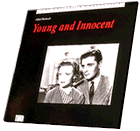

UK suspense
1937
bw 82 min.
Director: Alfred Hitchcock
CLV: $34.95 - available
1 disc, catalog # CC1116LY
In
Young and Innocent (1937) Alfred Hitchcock uses all the signs in his
visual vocabulary to tell one of his favorite stories: fugitive hero unjustly
accused of murder. Yet this is also a story of youth and innocence triumphant --
a light entertainment, a souffle made by a master chef. It's nestled between the
doom-laden Sabotage (1936) and the spy scenario of The Lady
Vanishes (1938) like a water pistol in a drawer full of handguns.Setting
off the plot line is a murder committed during a thunderstorm -- but
elliptically, off-camera. The violence we see -- a marital brawl between a
puritanical husband and free-spirited wife -- is mostly verbal and laced with
details that become important later. When the soon-to-be killer puffs on a
cigarette, lightning coincides with the glow of his inhalation. When he steps out
onto a balcony to contemplate revenge on his libertine wife, thunder punctuates
the nervous twitch of his eyes. Below him, a stormy sea pummels the shore. Nature
is a foil for his raging emotions.
"Youth" is Erica Burgoyne (Nova Pilbeam):
chief constable's daughter, Girl Guide, reluctant sleuth. "Innocence" is Robert
Tisdall (Derrick de Marney). He finds the body on the beach as gulls swarm
overhead. (Having just used birds as messengers of death in Sabotage,
Hitchcock was keen to continue that train of thought.) Robert finds himself
wrongly accused of murder, even by his own bespectacled solicitor. "Youth" and
"Innocence" must vindicate Robert on their own, unaided by the police. Even
Erica's father, decent Colonel Burgoyne, is no help. Though played by pleasant
Percy Marmont (the sympathetically portrayed murder victim in Secret
Agent), he too mistakenly believes in Robert's guilt.
A greater threat than
the police is Erica's clever aunt (Mary Clare). In a key scene, the children's
birthday party, the couple narrowly escape the suspicious matron and her prying
questions. They are saved by a game of Blind Man's Bluff contrived by Erica's
helpful uncle (Basil Radford, soon to appear as a rabid cricket fan in The
Lady Vanishes). With the blindfold on, Auntie is like the nearsighted
solicitor, her vision too feeble to see the truth. Like the twitchy-eyed killer,
she may not even want to see it, for beneath her suspicion of Robert lurks an
undertow of puritanical disapproval.
The birthday party scene begins with a
magician entertaining the children: me director, you audience. The connection
between children and audience members is doubly important because Hitchcock sees
both groups as noble innocents who know instinctively that Robert is innocent
too. Standing on the beach among his accusers, Robert appeals to us directly by
gazing into the camera, and he's still appealing to us in the next scene as he's
grilled by detectives.
The camera does some gazing of its own. In one of film
history's most celebrated crane shots, the camera pans from the Grand Hotel lobby
past a dividing wall and across the length of a huge ballroom, created on
Pinewood Studio's largest soundstage. Through Hitchcock's artistry. the audience
knows that the camera is zooming in on some truth -- a truth that will be
apparent when the camera stops.
Young and Innocent is not all doom and
gloom. Robert and Erica may barely survive capers like the mine disaster, but
these near-misses are just suspenseful tricks to keep the children amused. As
Robert hoists Erica to safety it is hard not to think of a similar sequence in
North by Northwest (1959), another innocent fugitive story with a light
touch. There is plenty of outright comedy here -- not black comedy as an
instrument of torture, as in Sabotage, but comedy for laughs. An example
is the pig farmer and his taunting of the constabulary, which moviegoers usually
greet with laughter. Hitchcock may have started a trend with his little pig/
police joke. He was never fond of cops; after this, no doubt the feeling was
mutual.
By Hitchcock's standards, Young and Innocent is a merry romp.
Its hero and heroine are untroubled by the shocking murders and moral ambiguities
of Secret Agent and Sabotage. The director must have felt his
public required some comic relief after those two dark works, especially
Sabotage, built around the death of a child. Hitchcock needed to
consolidate his position as cinematic magician, master of suspense -- not just
another serial murderer. Through the fresh-faced protagonists and birthday-party
revelers of Young and Innocent he found the freedom to celebrate youth,
innocence, and the safe romantic conventions of the cinema.
-- MARK
FLEISCHMAN
Credits
Producer: Edward Black
Director: Alfred
Hitchcock
Screenplay: Charles Bennett, Edwin Greenwood, Anthony
Armstrong
From "A Shilling for Candles" by: Josephine Tey
Dialogue: Gerald
Savory
Continuity: Alma Reville
Photography: Bernard Knowles
Art
Director: Alfred Junge
Editor: Charles Frend
Musical Director: Louis
Levy
Transfer
This edition of Young And Innocent was
transferred from a 35mm master print.




